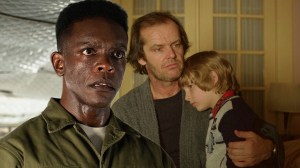Young Animal is defined by its embrace of the psychedelic. Every single comic in this imprint can be reasonably referred to as trippy, which makes calling one the most surreal a big statement. Cave Carson Has an Interstellar Eye is the most surreal comic at Young Animal. When the eye was only cybernetic, that might have been up for debate, but with this relaunch the series is entirely assured of itself and is shifting into strange new places without hesitation.
Videos by ComicBook.com
The first issue builds on the groundwork laid by the prior series without becoming self-referential. It has a team, a goal, and a set of expectations. The core trio of Cave, Chloe, and Marc are traipsing across space and between dimensions because that’s what explorers at DC Comics do. Their exploits are almost beyond imagining, but a familial team dynamic and blue collar approach to the work makes it an enjoyable ride. Nothing on the page needs to be explained beyond what it is, leaving the journey to be the driving force of the plot. Said journey starts with a visit to missing rock legend Star Adam (an homage to both David Bowie and Prince) who knew Cave and Marc long ago.
Musical references and discussion of old times provide a relatable foundation for an issue that takes place entirely off Earth. It foregrounds the small cast of characters as human beings. Cave might have an eye that can open pocket dimensions, but he’s also a guy who hosts a podcast and is trying to bond with his daughter. These latter elements are more important, while the eye and all of the other fantastical elements of the series light up the page and push the characters in new, unexpected directions. There is a core tension between the absurdity of each new scenario and the relatable function of these individuals, and Cave Carson Has an Interstellar Eye always defers to the latter.

None of that should undermine the wonderfully surreal nature of this comic. Its human essence is what allows it to function in such an abstract reality. The actual forms of the characters are malleable, primarily designed to convey the sense of people—lending proportions and emotion to a scene, without constructing a strict reality. Elements of velocity and change alter human bodies as well as the panels around them. When a crash or implosion shakes up the page, everything is blurred and contorted by the force. It’s a style of visual storytelling that wants you to feel the moment as much as witness it. Not every effect works, but there’s enough happening on each page to quickly move onto the next experiment.
All of this action is cast on a background of beautiful constructs and glowing colors. A space-faring mansion is as intriguing to enter as any reader might hope, complete with robot servants and other additions. There may be no better setting for the issue than actually traveling through space though. It’s here that Filardi’s colors bring Oeming’s line work to life, illuminating each panel and transforming the vacuum into something wondrous. Colors and visual effects tell the story as much as anything in this issue, shaping readers understanding of warm, new connections as well as cold, thrilling moments of tension. It’s possible to glance at these pages and sense what the story is about before reading the artwork or dialogue.
Cave Carson Has an Interstellar Eye shows readers that simply because a comic can be described as surreal or strange does not mean it should be incomprehensible. Each page of the issue toys with layouts and refuses to define any one moment too narrowly, yet the heart of the story is never in question. Both the characters and core themes of wonder, family, and exploration are clear. Even the most initially inexplicable choice is purposeful and rewards repeat readings. This comic is not strange for the sake of being strange, it provides a world that could only be imagined in comics and readers should be prepared for quite the trip.
Published by DC Comics
On March 21, 2018
Written by Jon Rivera
Art by Michael Avon Oeming
Colors by Nick Filardi








